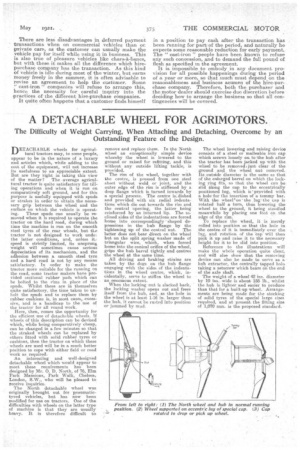A DETACHABLE WHEEL FOR AGRIMOTORS.
Page 23

If you've noticed an error in this article please click here to report it so we can fix it.
The Difficulty of Weight Carrying, When Attaching and Detaching, Overcome by an Outstanding Feature of the Design.
DETACHABLE wheels for agricultural tractors may, to some people, appear to be in the nature of a luxury and articles which, while adding to the
increase its of the equipment, will not ite usefulness to an appreciable extent. But are they right in taking this view of the matter? The .average agricultural tractor is quite satisfactory for tilling operations and when it is run on comparatively soft ground, and for this purpose is usefully equipped with spuds or strakes in order to obtain the necessary grip between the wheel and the surface on which the vehicle is operat
ing. These spuds can usually be removed when it is required to operate the tractor on the hard road, during which time the machine is run on the smooth steel tyres of the rear wheels, but the tractor is not designed to work undet the latter conditions, and, unless speed is strictly limited, its unsprung weight will sometimes cause serious depreciation of its mechanism, and the adhesion between a smooth steel tyre and a hard road is not by any means satisfactory. In order to make the tractor more suitable for the running on the road, some tractor makers have provided sectional rubber pads which can he bolted to the rims in place of the spuds. Whilst these are in themselves quite satisfactory, the time taken to unbolt the spuds and to replace them by rubber cushions is, in most cases, excessive, and is a handicap to the use of
the tractor for all round work. • Here, then, comes the opportunity for the efficient use of detachable wheels, if wheels of this description can be devised which, while being comparatively cheap, can be changed in a few minutes so that the straked wheels can be replaced by others fitted with solid rubber tyres or cushions, then the tractor on which these wheels are used will be in a much better position to cope with either field or road work as required. An interesting and well-designed detachable wheel which would appear to meet these requirements has been designed by Mr. O. D. North, of 76, Elm Park Mansions, Park Walk, Chelsea, London, S.W., who will be pleased to receive inquiries. The North detachable wheel was originally brought out for Rneumatictyred vehicles, but has now been modified for use on tractors. One of the difficulties with wheels on the latter type of machine is that they are usually heavy. It is therefore difficult to remove and replace them. In the North wheel an exceptionally simple device whereby the wheel is lowered to the ground or raised for refitting, and this without any outside lifting tackle, is provided.
The rim of the wheel, together with the centre, is pressed from one steel sheet without weld or joint, and the outer edge of the rim is stiffened by a deep flange which is turned inwards by a special process. The centre i5 dished and provided with six radial indentations which die out towards the rim and the central -opening, the latter being reinforced by an inturned lip. The inclined sides of the indentations are forced home into correspondingly shaped depressions in the hub flange by the tightening up of the central nut. The latter does not, bear direct on the wheel but on the split spring washer made of triangular wire, which, when forced home into the conical orifice of the wheel, grips the hub barrel tightly and centres the wheel it the same time.
All driving and braking strains are taken by the dogs on the hub flange engaging with the sides of the indentations in the wheel centre, which, incidentally, serve to stiffen the wheel to an enormous extent.
-When the locking mit is slacked back, the locking washer opens out and frees itself from the hub, and, as the hole in the wheel is at least 1-16 in, larger than the hub, it cannot be rusted into position or jammed by mud.
The wheel lowering and raising device, consists of a steel or malleable iron cap which screws loosely on to•the hub after
the tractor has been jacked up with the wheel to he removedrjust clear of the
ground and the wheel nut removed.
Its .outside diameter is the same as that of the enlarged barrel on which the lock ing ring fits, so that the wheel can be slid along the cap to the eccentrically positioned lug, which is provided with a hole for f he insertion of a tommy bar.
With the wheePon 'the lug ' the cap is rotated half a turn, thus lowering the
wheel to the ground, it being steadied meanwhile by placing one foot on the edge of the rim.
To replace the wheel, it is merely rolled into position so that the hole in
the centre of jt is immediately over the lug, and rotation of the --cap will then pick it up and raise it to the necessary height for it to he slid into position.
Reference to the illustrations will make the whole operation quite clear,
and will also show that the removing device can also be made to serve as a hub extractor, the centrally tapped hole taking a setscrew which bears on the end of the axle shaft.
The weight of a. wheel 42 ins, diameter by 10 ins, wide is about 185 lb., whilst the hub is lighter and easier to produce than that for a built-np wheel. Arrangements are being made for the stocking of solid tyres of the special large sizes required, and at present the fitting size of 1,070 mm. is the proposed standard.
































